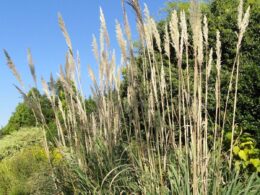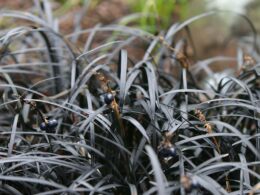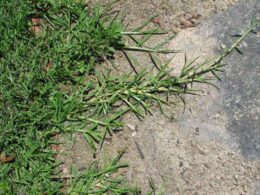Which Grass Types Grow Fast? Warm-Season Grasses
Before we get into how to grow grass fast, we need to understand the different types of grass. Warm-season grasses grow best in temperatures between 80 and 95 degrees Fahrenheit. They include:
- Bermuda grass;
- zoysia grass;
- centipede grass.
Out of these, Bermuda grass is the fastest-growing. It can germinate in as little as 5-7 days in the right conditions. In that case, you’ll have a full lawn of grass in 60-90 days. It takes 10 weeks on average for Bermuda grass to look lush.
Zoysia grass is a bit slower, taking between 14 and 21 days to germinate. However, it’s still a fast-growing grass. Once it takes root, you can expect a full lawn in about 90 days.
Finally, centipede grass is the slowest to germinate out of the listed warm-season grasses. It takes 21 days on average to sprout, and produces a good lawn after about 3 months of summer growth.
Cool-Season Grass Growth Rates
Cool-season grasses are more tolerant of cooler temperatures, typically growing best between 60 and 75 degrees Fahrenheit. If you’re planting them in the fall, you’ll have a beautiful lawn in early spring. Cool-season grasses include:
- fescue;
- ryegrass;
- Kentucky bluegrass.
Of these, ryegrass grows the fastest. It germinates in less than a week and is fully grown in about 50 days. It’s already mowable after 21 days, though it won’t look its best until the 50-day mark.
Fescue is a bit slower, taking between 14 and 21 days to germinate. However, it’s still a fast-growing grass. Once it takes root, you can expect a full lawn in about 60 days.
Finally, Kentucky bluegrass is the slowest to germinate out of the listed cool-season grasses. It takes 21 days on average to sprout, and produces a good lawn after about 75 days.
How to Grow Grass Fast: The Ultimate Guide
So, how to grow grass fast? If you’ve already picked out your grass type, here are some tips to get the quickest germination and growth possible.
- Choose the right time to plant grass. As we discussed, different grasses have different ideal growing temperatures. Make sure you plant your grass at the right time of year for optimal growth.
- Pick a sunny spot. Grass needs sunlight to grow, so make sure you choose an area of your yard that gets at least six hours of sun per day.
- Prepare the soil. Grass needs well-drained, loose soil to grow in. If your soil is too compacted, consider tilling it before planting. Add a layer of compost to help the grass grow.
- Use quality seed. You get what you pay for when it comes to grass seed. Cheap seed is more likely to be old and won’t germinate as well. Spend a few extra dollars on quality seed from a reputable source.
- Plant the seed correctly. Sow the seed at the recommended rate for your grass type. You can use a seed spreader to make sure the seed is evenly distributed.
- Water regularly. Grass needs water to grow, so make sure you keep the soil moist but not soggy. Water in the morning so the grass has time to dry out before nightfall.
Following these tips, you should have a beautiful, healthy lawn in no time. Just remember to be patient; grass doesn’t grow overnight!
How to Care for Your New Lawn?
Now that you’ve learned how to grow grass fast, it’s time to talk about how to care for your new grass lawn. Here are a few tips:
- Mow regularly. Grass needs to be mowed regularly to stay healthy. Mowing also helps prevent weeds from taking over your lawn. Make sure you’re using a sharp blade. A dull blade will tear the grass, making it more susceptible to disease. Also, stick to the recommended height for your grass type.
- Water deeply and less often. Established grass can withstand longer periods without water. Water deeply to encourages grass roots to grow deep and make your lawn more drought-resistant.
- Fertilize in the spring. A quality fertilizer will help your grass grow thick and green.
- Control weeds. Weeds compete with grass for water and nutrients. Pull them by hand or use a herbicide to get rid of them.
- Aerate your lawn. Aerating helps improve drainage and encourages grass roots to grow. It also reduces compaction and thatch buildup.
Hydroseeding: What Is It, and How Does It Speed Up Lawn Growth?
Hydroseeding is a process where water, seed, and fertilizer are mixed together and sprayed onto your lawn. Because of the built-in fertilizer, it’s a good option if you’re wondering how to grow grass fast with little effort.
You can get a specialized grass slurry from a lawn care company, or mix your own. The benefits of hydroseeding as an alternative to laying sod include:
- quicker germination;
- easier and more cost-effective seeding on larger areas;
- better grass to soil contact.
Hydroseeding is perfect for large lawns or areas where it’s difficult to get seed to stick. It’s also great if you’re planting on a slope, although less effective than sod.
While it’s more expensive than traditional seed planting, hydroseeding is worth the investment if you’re looking for fast results. With proper watering, you can expect a 3-inch-long lawn within a month. Of course, the results will depend on the weather.
Enjoy Your Lush Lawn in No Time
So, how to grow grass fast? The process starts with choosing the right type of grass for your climate and planting the seed at the right time of year. For the best results, use quality seed and water regularly. You can also try hydroseeding for faster results. With a little patience and effort, you’ll have a lush lawn in no time!



















